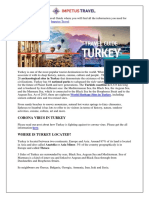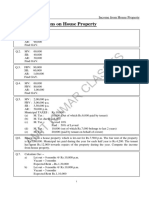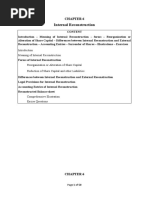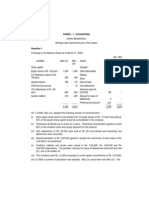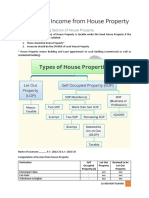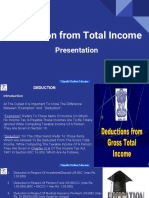Salary Illustration
Salary Illustration
Uploaded by
Sarvar PathanCopyright:
Available Formats
Salary Illustration
Salary Illustration
Uploaded by
Sarvar PathanOriginal Title
Copyright
Available Formats
Share this document
Did you find this document useful?
Is this content inappropriate?
Copyright:
Available Formats
Salary Illustration
Salary Illustration
Uploaded by
Sarvar PathanCopyright:
Available Formats
Q.1) Mr. C who is currently employed with JSM Ltd.
furnishes you with the following
information:
1. The details of monthly salary for the year ended 31-3-2016 are as under:
a. Basic Salary per month - RS.5,000
b. Dearness Allowance per month:
i. From 1-4-2015 to 31-12-2015 - 25% of Basic
ii. From 1-1-2016 to 31-3-2016 - 32% of Basic
c. Professional Tax Deducted per month - Rs.120
2. Taxable conveyance allowance - Rs.3,500
3. Bonus @ 20% on Basic plus Dearness Allowance
4. Medical Premium paid by employer on behalf of Mr. C - Rs.2,800
Compute his taxable salary for the assessment year 2016-17.
Solution:
Name of Assessee : Mr. C
Assessment Year : 2016-17
Previous Year : 2015-16
Status : Individual
Residential Status : R&OR
Pan No : _________
Computation of Income from Salary
Particulars Rs. Rs.
1. Salary & Allowances:
a. Basic (Rs.5,000 x 12) 60,000
b. D.A (upto December) 25% of (Rs.5,000 x 9) 11,250
c. D.A (Jan. - March) 32% of (Rs.5,000 x 3) 4,800 16,050
d. Conveyance allowance 3,500
e. Bonus [20% of (60,000 + 16,050)] 15,210
2. Gross Taxable Salary 94,760
3. Less: Deduction u/s 16
a. Professional Tax (120 x 12) 1,440
4. Net Taxable Salary (2 - 3) 93,320
Note: Mediclaim premium paid by the company is an exempt perquisite
Q.2) Mr. Dharmesh Gandhi, an employee of Tata Ltd., covered by the Payment of Gratuity Act,
1972, retires on 31st January 2016, after 35 years and 7 months service. At the time of retirement
his employer paid him gratuity of Rs.65,000 and he received Rs.50,000 being the accumulated
balance of Statutory Provident Fund. The due date of salary and allowances etc. was 1st day of
the next month and were paid on due date. He was entitled to monthly pension of Rs.400 with
Tripathi Online Educare
1
effect from 1st day of February, 2016, which becomes due on the last day of the month.
Professional Tax is Rs.800.
Compute the taxable income of Mr. Dharmesh for the Assessment Year 2016-17 on the basis of
the following further information:
1. Basic Salary Rs.2,500 p.m.
2. House Rent Allowance Rs.400 p.m. Taxable value is 50% of the amount received.
3. Project Allowance paid during the year Rs.12,000.
4. Bonus paid during the year Rs.3,600.
5. At retirement, on encashment of earned leave at his credit of 15 months he received
Rs.37,500.
Solution:
Name of Assessee : Mr. Dharmesh Gandhi
Assessment Year : 2016-17
Previous Year : 2015-16
Status : Individual
Residential Status : R&OR
Pan No : _________
Computation of Income from Salary
Particulars Rs. Rs.
1. Salary & Allowances:
a. Salary (2,500 x 11) 27,500
b. House Rent Allowance (400 x 50% x 11) 2,200
c. Project Allowance 12,000
d. Bonus 3,600
e. Gratuity 65,000
Less: Exempt u/s 10(10) (WN 1) 51,923 13,077
f. Leave Encashment 37,500
Less: Exempt u/s 10(10AA) (WN 2) 25,000 12,500
g. Pension (400 x 2) 800
2. Gross Salary 71,677
3. Less: Deduction u/s 16
a. Professional Tax 800
4. Net Taxable Salary (2 - 3) 70,877
Notes:
1. Gratuity: An employee covered under payment of Gratuity Act, 1972 is entitled to
exemption u/s 10(10) to the extent of the least of the following amounts:
a. Actual Amount Received Rs.65,000
b. 15 days salary (i.e. 15/26 working days x salary p.m.) based on
the salary last drawn for every completed year of service or part
Tripathi Online Educare
2
thereof in excess of six months [i.e. Rs.2,500 x (15/26) x 36] Rs.51,923
c. Monetary Limit Rs.10,00,000
Thus, the exemption in this case is Rs.51,923
2. Leave Encashment: The least of the following is exempt u/s 10(10AA):
a. Actually Amount Received Rs.37,500
b. 10 x Average Salary (i.e. 10 x 2,500) Rs.25,000
c. Cash equivalent of leave calculated at 30 days credit
for each year of service.
[In one year 30 days credit is allowed that means for 35 years it
will be 1,050 days (30 x 35). Rs.2,500 is the salary of 30 days
therefore 1,050 days salary will be Rs.87,500 (2,500 x 1,050/30)] Rs.87,500
d. Monetary Limit Rs.3,00,000
So, exempt amount is Rs.25,000.
3. Due Basis:
a. Salary of Mar.2015 is taxable on due basis on 1-4-2015 i.e. in previous year
2015-16. Apr.2015 to Dec.2015 salaries will also be taxed in the same previous
year. Hence total salaries taxable will be for 11 months.
b. Pension being due on last day of the month is for two months.
Q.3) Mr. X joined a company AB Ltd. on June 1, 2015 and was paid the following emoluments
and allowed perquisites as under:
Emoluments:
1. Basic Pay Rs.50,000 per month
2. Dearness Allowance Rs.20,000 per month
3. Bonus (Target Achiever) Rs.1,00,000 per month
Perquisites:
1. Furnished accommodation owned by the employer and provided free of cost. Taxable
value of this rent free furnished accommodation was Rs.2,56,000.
2. The company paid medical insurance premium of Mr.X amounting to Rs.15,000.
Before joining the company AB Ltd. he was a Central Government employee and retired on May
31, 2015. He was pad the following emoluments and perquisites till May 31, 2015 by the
Government.
1. Basic Salary Rs.96,000 p.a.
2. Dearness Allowance Rs.6,000 p.a
3. Entertainment Allowance since 1962 Rs.24,000 p.a.
From June 1, 2015 he receives the monthly pension of Rs.3,000 from the Government. He
received Rs.30,000 as Leave Salary in respect of earned leave at his credit. He received
Rs.1,20,000 as gratuity. Compute the taxable salary of Mr. X for the Assessment Year 2016-17.
Solution:
Tripathi Online Educare
3
Name of Assessee : Mr. X
Assessment Year : 2016-17
Previous Year : 2015-16
Status : Individual
Residential Status : R&OR
Pan No : _________
Computation of Income from Salary
Particulars Rs. Rs.
A. Gross Salary
a. From AB Ltd
i. Basic (50,000 x 10) 5,00,000
ii. Dearness Allowance (20,000 x 10) 2,00,000
iii. Bonus (1,00,000 x 10) 10,00,000
iv. Rent free Furnished Accommodation 2,56,000 19,56,000
b. From Central Government
i. Basic (96,000 x 2/12) 16,000
ii. Dearness Allowance (6,000 x 2/12) 1,000
iii. Entertainment Allowance (24,000 x 2/12) 4,000
iv. Monthly Pension (3,000 x 10) 30,000 51,000
Gross Salary (a+b)
B. Less: Deduction u/s 16
a. Entertainment Allowance u/s 16(ii) (Least of
following)
i. Actual Amount Received 3,400
ii. ⅕ th of Basic Salary (16,000 + 1,000) 5,000
iii. Maximum Amount 4,000 3,400
C. Net Taxable Salary (A - B) 20,03,600
Notes:
1. Leave Salary 10(10AA) & Gratuity 10(10) - Exempted fully for Government Employee.
2. Medical Premium paid by the Employer is not a taxable Perquisite.
Q.4) Mr. Viren, who retired from the services of Hotel Star Ltd. on 31-12-2015 after being in
service for 8 year, received the following amounts from his employer for the year ending on
31-3-2016:
1. Salary @ Rs.15,000 p.m. comprising of basic salary of Rs.8,000, dearness allowance for
Rs.4,000 (which forms part of salary for retirement benefits) and city compensatory
allowance of Rs.3,000. This has been his revised salary structure from 1-1-2015.
2. Pension @ 25% of basic salary and dearness allowance from 1-1-2016.
Tripathi Online Educare
4
3. Leave encashment received Rs.1,12,000 for 280 days of leave accumulated during 8
years @35 days leave in each year. He has not availed any earned leave during his tenure
of 8 years and utilized only his annual casual leave.
4. Gratuity of Rs.80,000.
Compute the income of Mr. Viren chargeable under the head “Salaries” for the A.Y. 2016-17,
assuming that he is not covered under the Payment of Gratuity Act, 1972.
Solution:
Name of Assessee : Mr. Viren
Assessment Year : 2016-17
Previous Year : 2015-16
Status : Individual
Residential Status : R&OR
Pan No : _________
Computation of Income from Salary
Particulars Rs. Rs.
1. Gross salary received during 1-4-2015 to 31-12-2015 @
Rs.15,000 p.m (15,000 x 9) 1,35,000
2. Pension for 3 months @ 25% of (8,000 + 4,000) 9,000
3. Leave Salary 1,12,000
Less: Exempt u/s 10(10AA) (WN 1) 96,000 16,000
4. Gratuity 80,000
Less: Exempt u/s 10(10) (WN 2) 48,000 32,000
Income from Salary 1,92,000
Notes:
1. Leave Encashment is exempt to the extent of least of the following:
a. Actual Amount Received Rs.1,12,000
b. 10 months average salary [(8,000 + 4,000) x 10] Rs.1,20,000
c. Cash equivalent of leave calculated at 30 days credit
for each year of service.
[In one year 30 days credit is allowed that means for 8 years it
will be 240 days (30 x 8). Rs.12,000 is the salary of 30 days
therefore 240 days salary will be Rs.96,000 (12,000 x 240/30)] Rs.96,000
d. Monetary Limit Rs.3,00,000
Therefore, Rs.96,000 is exempt u/s 10(10AA).
2. Gratuity is exempt to the extent of least of the following:
a. Actual Amount Received Rs.80,000
b. ½ month avg salary for 8 years of service (12,000/2 x 8) Rs.48,000
c. Monetary Limit Rs.10,00,000
Therefore, Rs.48,000 is exempt u/s 10(10)
Tripathi Online Educare
5
Q.5) Mr. Narendra, who retired from the service of Hotel Samode Ltd. on 31-01-2016 after
putting in service for 5 years, received the following amounts from the employer for the year
ending on 31-03-2016.
1. Salary @ Rs.16,000 p.m. comprising of basic salary of Rs.10,000, Dearness allowance
(not forming part of salary for retirement benefits) of Rs.3,000, City Compensatory
allowance of Rs.2,000 and Night Duty Allowance of Rs.1,000.
2. Pension @30% of Basic Salary from 01-02-2016.
3. Leave salary of Rs.75,000 for 225 days of leave accumulated during 5 years @ 45 days
leave in each year. He has not availed any earned leave during his tenure of 5 years and
utilised only his casual leave.
4. Gratuity of Rs.50,000 (not covered under the Payment of Gratuity Act).
Solution:
Name of Assessee : Mr. Narendra
Assessment Year : 2016-17
Previous Year : 2015-16
Status : Individual
Residential Status : R&OR
Pan No : _________
Computation of Income from Salary
Particulars Rs. Rs.
1. Gross salary received during 1-4-2015 to 31-01-2016 @
Rs.16,000 p.m (16,000 x 10) 1,60,000
2. Pension for 2 months @ 30% of 10,000 p.m. 6,000
3. Leave Salary 75,000
Less: Exempt u/s 10(10AA) (WN 1) 50,000 25,000
4. Gratuity 50,000
Less: Exempt u/s 10(10) (WN 2) 25,000 25,000
Income from Salary 2,16,000
Notes:
1. Leave Encashment is exempt to the extent of least of the following:
a. Actual Amount Received Rs.75,000
b. 10 months average salary [10,000 x 10] Rs.1,00,000
c. Cash equivalent of leave calculated at 30 days credit
for each year of service.
[In one year 30 days credit is allowed that means for 5 years it
will be 150 days (30 x 5). Rs.10,000 is the salary of 30 days
therefore 150 days salary will be Rs.50,000 (10,000 x 150/30)] Rs.50,000
d. Monetary Limit Rs.3,00,000
Tripathi Online Educare
6
Therefore, Rs.50,000 is exempt u/s 10(10AA).
2. Gratuity is exempt to the extent of least of the following:
a. Actual Amount Received Rs.50,000
b. ½ month avg salary for 5 years of service (10,000/2 x 5) Rs.25,000
c. Monetary Limit Rs.10,00,000
Therefore, Rs.25,000 is exempt u/s 10(10)
3. Dearness allowance does not form part of salary for retirement benefits and therefore,
not included in “Salary” for the purpose of computation of leave encashment and
gratuity.
Q.6) Mr. X is working in ABC Ltd. and has given the details of his income for the P.Y. 2015-16.
You are required to compute his gross salary from the details given below:
1. Basic Salary Rs.1,00,000 p.m.
2. D.A (50% is for retirement benefits) Rs.80,000 p.m.
3. Commission @1% of turnover.
4. Turnover during the year is Rs.50,00,000.
5. Bonus Rs.4,00,000.
6. Gratuity Rs.2,50,000.
7. His own contribution in RPF is Rs.2,00,000.
8. Employer’s contribution to RPF is 20% of Basic Salary (exempt Rs.2,07,600).
9. Interest accrued on RPF @ 13% p.a. is Rs.1,30,000 (exempt Rs.95,000)
Solution:
Name of Assessee : Mr. X
Assessment Year : 2016-17
Previous Year : 2015-16
Status : Individual
Residential Status : R&OR
Pan No : _________
Computation of Income from Salary
Particulars Rs. Rs.
1. Basic Salary (Rs.1,00,000 x 12) 12,00,000
2. Dearness Allowance (Rs.80,000 x 12) 9,60,000
3. Commission on Turnover (50,00,000 x 1%) 50,000
4. Bonus 4,00,000
5. Gratuity (WN 1) 2,50,000
6. Employee’s Contribution to RPF (WN 2) NIL
7. Employer’s Contribution to RPF (12,00,000 x 20%) 2,40,000
Less: Exempt (given) 2,07,600 32,400
8. Interest accrued on RPF @13% p.a 1,30,000
Tripathi Online Educare
7
Less: Exempt (given) 95,000 35,000
Gross Salary 29,27,400
Note:
1. Gratuity received during service is fully taxable.
2. Employee’s contribution to RPF is not taxable. It is eligible for deduction u/s 80C.
Q.7) Mr. G receives the following emoluments during the previous year ending 31-03-2016:
1. Basic Pay Rs.4,00,000
2. Dearness Allowance Rs.1,50,000
3. Commision Rs.1,00,000
4. Entertainment Allowance Rs.40,000
5. Medical Expenses Reimbursed Rs.25,000
6. Professional Tax paid Rs.3,000 (Rs.2,000 was paid by his employer)
Mr. G contributes Rs.50,000 towards Recognised Provident Fund. He has no other income.
Determine the income from Salary for A.Y. 2016-17, if Mr. G is a State Government Employee.
Solution:
Name of Assessee : Mr. G
Assessment Year : 2016-17
Previous Year : 2015-16
Status : Individual
Residential Status : R&OR
Pan No : _________
Computation of Income from Salary
Particulars Rs. Rs.
A. Gross Salary
a. Basic Salary 4,00,000
b. Dearness Allowance 1,50,000
c. Commission 1,00,000
d. Entertainment Allowance Received 40,000
e. Employee’s Contribution to RPF (WN 1) NIL
f. Medical Expenses Reimbursed 25,000
Less: Exempt 15,000 10,000
g. Professional Tax paid by Employer (WN 2) 2,000
Gross Salary 7,02,000
B. Less: Deduction u/s 16
a. Entertainment Allowance u/s 16(ii) (Least of
following)
i. Actual Amount Received - Rs.40,000
ii. ⅕ th of Basic Salary (4,00,000 x ⅕) - Rs.80,000
Tripathi Online Educare
8
iii. Monetary Limit - Rs.5,000
b. Professional Tax Paid u/s 16(iii) (WN 2) 5,000
Income from Salary (A-B) 3,000 8,000
6,94,000
Note:
1. Employee's contribution to RPF is not taxable instead it is eligible for deduction u/s 80C.
2. Profession Tax paid by employer, being a perquisite is added to salary and then total
professional tax paid is allowed to be deducted from salary.
Q.8) Mr. Anand, an employee of XYZ Co. Ltd at Mumbai is covered by Payment of Gratuity
Act, retires at the age of 64 years on 31-12-2015 after completing 33 years and 7 months of
service. At the time of retirement, his employer pays Rs.20,51,640 as Gratuity. He is also entitled
for monthly pension of Rs.8,000. He gets 75% of pension commuted for Rs.4,50,000 on 1st
February, 2016.
Determine the salary chargeable to tax for Mr. Anand for the assessment year 2016-17 with the
help of following information:
1. Basic Salary (Rs.80,000 x 9) Rs.7,20,000.
2. Bonus Rs.36,000.
3. House Rent Allowance (Taxable) Rs.1,17,000.
4. Employer’s Contribution towards Recognised Provident Fund Rs.1,10,000 (Exempt
Rs.86,400).
5. Professional Tax paid by Mr. Anand Rs.2,000.
Salary and Pension falls due on the last day of each month.
Solution:
Name of Assessee : Mr. Anand
Assessment Year : 2016-17
Previous Year : 2015-16
Status : Individual
Residential Status : R&OR
Pan No : _________
Computation of Income from Salary
Particulars Rs. Rs.
A. Gross Salary
a. Basic Salary (Rs.80,000 x 9) 7,20,000
b. Bonus 36,000
c. House Rent Allowance (Taxable) 1,17,000
d. Employer’s Contribution to RPF 1,10,000
Less: Exempt (given) 86,400 23,600
Tripathi Online Educare
9
e. Gratuity Received 20,51,640
Less: Exempt (WN 1) 10,00,000 10,51,640
f. Pension
a. Uncommuted [(8000 x 1) + (2,000 x 2)] 12,000
b. Commuted Value Received 4,50,000
Less: Exempt (WN 2) 2,00,000 2,50,000 2,62,000
Gross Salary 22,10,240
B. Less: Deduction u/s 16
a. Professional Tax Paid u/s 16(iii) 2,000
C. Net Taxable Salary (A - B) 22,08,240
Notes:
1. Gratuity: An employee covered under payment of Gratuity Act, 1972 is entitled to
exemption u/s 10(10) to the extent of the least of the following amounts:
a. Actual Amount Received Rs.20,51,640
b. 15 days salary (i.e. 15/26 working days x salary p.m.) based on
the salary last drawn for every completed year of service or part
thereof in excess of six months [i.e. Rs.80,000 x (15/26) x 34] Rs.15,69,231
c. Monetary Limit Rs.10,00,000
Thus, the exemption in this case is Rs.10,00,000
2. Commuted Pension
Since, Mr. Anand is a non-government employee in receipt of gratuity, exemption u/s
10(10A), would be available to the extent of ⅓ rd of Fully Commuted Value (FCV).
FCV = 4,50,000 X 100/75
= Rs.6,00,000
Exempted Commuted Pension = ⅓ of FCV
= 6,00,000 X ⅓
= Rs.2,00,000
Tripathi Online Educare
10
You might also like
- Problems On Income From Salaries: Tax SupplementNo ratings yetProblems On Income From Salaries: Tax Supplement20 pages
- Problems On Taxable Salary Income Additional PDFNo ratings yetProblems On Taxable Salary Income Additional PDF24 pages
- Income From House Property: Solution To Assignment SolutionsNo ratings yetIncome From House Property: Solution To Assignment Solutions4 pages
- Underwriting of Shares & Debentures - CWNo ratings yetUnderwriting of Shares & Debentures - CW32 pages
- Ca Inter - Nov 2018 - Advanced Accounts - Suggested Answers PDF0% (1)Ca Inter - Nov 2018 - Advanced Accounts - Suggested Answers PDF28 pages
- Problems and Solutions On Advance Tax: Problem No. 1No ratings yetProblems and Solutions On Advance Tax: Problem No. 18 pages
- Assets.: (Vi) Due To Lack of Information, Depreciation Has Not Been Provided On Fixed100% (1)Assets.: (Vi) Due To Lack of Information, Depreciation Has Not Been Provided On Fixed6 pages
- Calculation of Depreciation As Per Income Tax Act100% (2)Calculation of Depreciation As Per Income Tax Act12 pages
- Income From House Property Assignment EscholarsNo ratings yetIncome From House Property Assignment Escholars22 pages
- Final Accounts 1. As Per Schedule III of Companies Act 2013, Prepare Financial Statement For Gillette India PVT LTD100% (1)Final Accounts 1. As Per Schedule III of Companies Act 2013, Prepare Financial Statement For Gillette India PVT LTD3 pages
- 6 - COMPUTATION OF TAXABLE VALUE - Q - As - AFTER SESSION - 9No ratings yet6 - COMPUTATION OF TAXABLE VALUE - Q - As - AFTER SESSION - 921 pages
- Problems On Profit Prior To IncorporationNo ratings yetProblems On Profit Prior To Incorporation18 pages
- Accounting For Branches Including Foreign Branch Accounts: © The Institute of Chartered Accountants of India100% (1)Accounting For Branches Including Foreign Branch Accounts: © The Institute of Chartered Accountants of India53 pages
- Liquidation of Company: Important Points of Our Notes/BooksNo ratings yetLiquidation of Company: Important Points of Our Notes/Books20 pages
- Underwriting of Shares and Debentures - PROBLEMS100% (1)Underwriting of Shares and Debentures - PROBLEMS4 pages
- Chapter 2 - Income From House Property - Notes50% (2)Chapter 2 - Income From House Property - Notes27 pages
- Individual Account Opening Form: (Demat + Trading)No ratings yetIndividual Account Opening Form: (Demat + Trading)27 pages
- Mi 4A PRO 80 CM 32 HD Ready LED Smart Android TV With Google Data SaverNo ratings yetMi 4A PRO 80 CM 32 HD Ready LED Smart Android TV With Google Data Saver2 pages
- Acknowledgement of Online Application For Services On Existing DLNo ratings yetAcknowledgement of Online Application For Services On Existing DL1 page
- Acknowledgement of Online Application For Services On Existing DLNo ratings yetAcknowledgement of Online Application For Services On Existing DL1 page
- Important Theory Questions: Tripathi Online EducareNo ratings yetImportant Theory Questions: Tripathi Online Educare1 page
- Where at Cebu May 15-July 15 2012 IssueNo ratings yetWhere at Cebu May 15-July 15 2012 Issue36 pages
- West Bengal Services Death-cum-Retirement Benefit Rules-1971 PDFNo ratings yetWest Bengal Services Death-cum-Retirement Benefit Rules-1971 PDF127 pages
- 2015 California Restaurant Employee HandbookNo ratings yet2015 California Restaurant Employee Handbook52 pages
- (Art 287) 4. Sta Catalina College Vs NLRCNo ratings yet(Art 287) 4. Sta Catalina College Vs NLRC5 pages
- US Internal Revenue Service: I8027 - 2000No ratings yetUS Internal Revenue Service: I8027 - 20004 pages
- Title Seven (Termination of Employment Contract and End of Service Gratuity)No ratings yetTitle Seven (Termination of Employment Contract and End of Service Gratuity)12 pages
- Hutt City Council's Sensitive Expenditure GuidelinesNo ratings yetHutt City Council's Sensitive Expenditure Guidelines17 pages
- Pandu Topno's Gratuity Appeal - Affirmed by Hon High CourtNo ratings yetPandu Topno's Gratuity Appeal - Affirmed by Hon High Court27 pages
- Income From House Property: Solution To Assignment SolutionsIncome From House Property: Solution To Assignment Solutions
- Ca Inter - Nov 2018 - Advanced Accounts - Suggested Answers PDFCa Inter - Nov 2018 - Advanced Accounts - Suggested Answers PDF
- Problems and Solutions On Advance Tax: Problem No. 1Problems and Solutions On Advance Tax: Problem No. 1
- Assets.: (Vi) Due To Lack of Information, Depreciation Has Not Been Provided On FixedAssets.: (Vi) Due To Lack of Information, Depreciation Has Not Been Provided On Fixed
- Final Accounts 1. As Per Schedule III of Companies Act 2013, Prepare Financial Statement For Gillette India PVT LTDFinal Accounts 1. As Per Schedule III of Companies Act 2013, Prepare Financial Statement For Gillette India PVT LTD
- 6 - COMPUTATION OF TAXABLE VALUE - Q - As - AFTER SESSION - 96 - COMPUTATION OF TAXABLE VALUE - Q - As - AFTER SESSION - 9
- Accounting For Branches Including Foreign Branch Accounts: © The Institute of Chartered Accountants of IndiaAccounting For Branches Including Foreign Branch Accounts: © The Institute of Chartered Accountants of India
- Liquidation of Company: Important Points of Our Notes/BooksLiquidation of Company: Important Points of Our Notes/Books
- Individual Account Opening Form: (Demat + Trading)Individual Account Opening Form: (Demat + Trading)
- Mi 4A PRO 80 CM 32 HD Ready LED Smart Android TV With Google Data SaverMi 4A PRO 80 CM 32 HD Ready LED Smart Android TV With Google Data Saver
- Acknowledgement of Online Application For Services On Existing DLAcknowledgement of Online Application For Services On Existing DL
- Acknowledgement of Online Application For Services On Existing DLAcknowledgement of Online Application For Services On Existing DL
- Important Theory Questions: Tripathi Online EducareImportant Theory Questions: Tripathi Online Educare
- West Bengal Services Death-cum-Retirement Benefit Rules-1971 PDFWest Bengal Services Death-cum-Retirement Benefit Rules-1971 PDF
- Title Seven (Termination of Employment Contract and End of Service Gratuity)Title Seven (Termination of Employment Contract and End of Service Gratuity)
- Hutt City Council's Sensitive Expenditure GuidelinesHutt City Council's Sensitive Expenditure Guidelines
- Pandu Topno's Gratuity Appeal - Affirmed by Hon High CourtPandu Topno's Gratuity Appeal - Affirmed by Hon High Court












